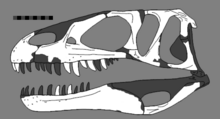Dubreuillosaurus
| Dubreuillosaurus | |
|---|---|

| |
| Reconstructed skull | |
| Scientific classification | |
| Domain: | Eukaryota |
| Kingdom: | Animalia |
| Phylum: | Chordata |
| Clade: | Dinosauria |
| Clade: | Saurischia |
| Clade: | Theropoda |
| Family: | †Megalosauridae |
| Genus: | †Dubreuillosaurus Allain, 2005 |
| Species: | †D. valesdunensis
|
| Binomial name | |
| †Dubreuillosaurus valesdunensis (Allain, 2002 [originally Poekilopleuron])
| |
| Synonyms | |
| |
Dubreuillosaurus is a
Discovery and naming
In 1994, the mayor of
In 2002, when this process had not yet been completed, Ronan Allain, after having dedicated a thesis to it,[1] named the find as a new species of Poekilopleuron: Poekilopleuron? valesdunensis. The specific name referred to the nearby ancient battlefield of the Battle of Val-ès-Dunes, where William the Conqueror had in 1046 defeated his enemies. The naming paper also contained a description of the skull.[2] The question mark after the generic name already indicated the assignment to Poekilopleuron was tentative. By 2005, Allain had come to the conclusion that the new species was not part of Poekilopleuron. He therefore created the new genus name Dubreuillosaurus for this species, the name honouring the Dubreuil family. The type species of the genus is the original Poekilopleuron valesdunensis, the combinatio nova is Dubreuillosaurus valesdunensis. The 2005 paper also contained a description of the postcranial skeleton.[3]
The
Description
Dubreuillosaurus was physically comparable to Eustreptospondylus. The holotype was an individual by Gregory S. Paul estimated to measure 5 metres (16 ft) long and to weigh 250 kilograms (550 lb).[4] However, this was a subadult; the adult length is uncertain, though it has been indicated as high as 9 metres (30 ft).
In 2005, Allain established some distinctive traits. Dubreuillosaurus has an unusually low and long skull, with a length three times the height. In the upper corner of the front edge of the nasal branch of the maxilla, a kink is present, separating a convex curvature below from a concave curvature above. The descending branch of the postorbital has a U-shaped cross-section. The parietal bones are not visible in side view. The supratemporal fenestra has a straight inner edge. A paraquadratic fenestra is lacking. A well-developed process is present on the underside of the jugal branch of the ectopterygoid. The rear edge of the jugal branch of the ectopterygoid, in front of the infratemporal fenestra, is deeply grooved. The lower jaw has a large external mandibular fenestra. The foramen mylohyoideum is largely oriented to the front and below. The head of the thighbone is directed to the inside and below. The front underside of the thighbone has a concave surface.[3] In 2012 Matthew Carrano added one autapomorphy: on the rear of the braincase there is a notch between the basioccipital and the bone surface formed by the exoccipitals and the opisthotic.[5]
Dubreuillosaurus seemed to lack any sort of crest or horns, but the only known specimen is a juvenile, and it is possible that these structures developed in later life. Like its relatives, Dubreuillosaurus probably had short, powerful arms with three-fingered hands.[6]
Phylogeny
In 2002, Poekilopleuron? valesdunensis was assigned to the
The phylogenetic position of Dubreuillosaurus according to Carrano et al. is shown by this cladogram:[5]
| Megalosauroidea |
| ||||||||||||||||||||||||||||||||||||||||||
Cau (2024) called the diagnosis of Dubreuillosaurus into question, considering it a
Paleobiology
During the Middle Jurassic much of Europe consisted of a number of islands. The fossil of Dubreuillosaurus was discovered in sedimentary rocks that were laid down in coastal, mangrove swamps at the east coast of the Armorican Massif. This suggests that it might have hunted fish and other marine prey.[6] Allain in 2002 described P? valesdunensis as a fish eater or piscivore but this was influenced by the fact that the holotype of Poekilopleuron bucklandii had been found together with fish remains.[2] Though uncovered at an island Dubreuillosaurus did not show the effects of insular dwarfism; like with Eustreptospondylus its small size is due to its being a subadult.
References
- ^ Allain, R., 2002, Les Megalosauridae (Dinosauria, Theropoda). Nouvelle découverte et révision systématique: Implications phylogénétiques et paléobiogéographiques. Paris. Thesis, Muséum national d'histoire naturelle 329 pp
- ^ S2CID 85751613.
- ^ a b c Allain, R., 2005, "The postcranial anatomy of the megalosaur Dubreuillosaurus valesdunensis (Dinosauria Theropoda) from the Middle Jurassic of Normandy, France", Journal of Vertebrate Paleontology 25(4): 850–858
- ^ Paul, G.S., 2010, The Princeton Field Guide to Dinosaurs, Princeton University Press p. 86
- ^ a b c Carrano, M.T.; Benson, R.B.J.; Sampson, S.D., 2012, "The phylogeny of Tetanurae (Dinosauria: Theropoda)". Journal of Systematic Palaeontology 10 (2): 211–300, doi:10.1080/14772019.2011.630927
- ^ ISBN 978-0-7566-9910-9.
- .
External links
- Dubreuillosaurus Archived 2007-07-13 at the Wayback Machine in the Dino Directory
